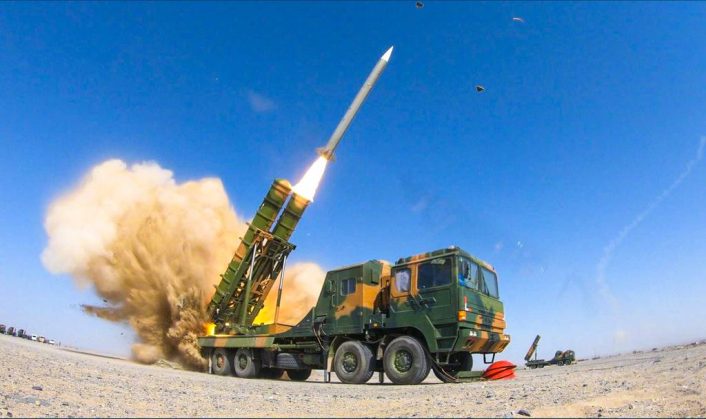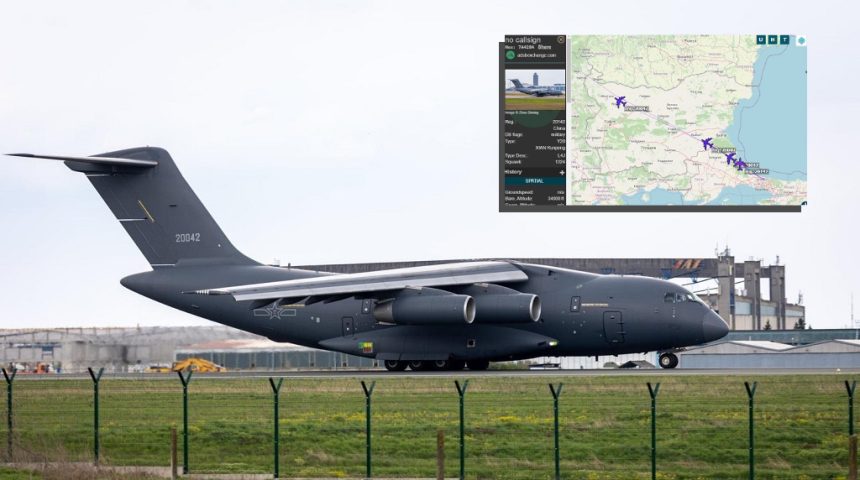The six Y-20 cargo aircraft landed in Belgrade to deliver FK-3 surface-to-air missiles as the Serbian military continues to rearm.
During the night between April 8 and 9, 2022, six People’s Liberation Army Air Force (PLAAF) Y-20 cargo planes suddenly appeared on flight tracking websites over Turkey and headed for Europe. As it turned out, the aircraft were headed to Belgrade’s Nikola Tesla International Airport, Serbia, where they landed to deliver FK-3 surface-to-air missiles, the export variant of the HQ-22 “Red Banner” SAM system.
The Y-20 were first tracked through MLAT (multilateration) north of Istanbul, Turkey, where some of them seemingly made a fuel stop, while some others appeared to have landed at Baku airport, Azerbaijan. The flights immediately caught the attention of flight trackers as it was unusual to see this many Y-20 in flight at the same time. Further flights reportedly arrived in Serbia over the next two days.
Likely not alone.
PLAAF 🇨🇳 Y-20A 20049 #7A4287 landed at Baku, Azerbaijan as well 3 hours ago. https://t.co/gO2wfBHAY5 pic.twitter.com/wvju4AmXgu
— Evergreen Intel (@vcdgf555) April 9, 2022
Y-20A number six.
Recap:
The following six PLAAF 🇨🇳 Y-20As have been seen heading for Serbia:
20041 #7A4281
20042 #7A4282
20045 #7A4285
20047 #7A427F
20049 #7A4287
20142 #7A428A pic.twitter.com/RCqBjlSz8U
— Evergreen Intel (@vcdgf555) April 9, 2022
Nikola Tesla Airport 🇷🇸🇨🇳 pic.twitter.com/wVMoZCdECR
— ZOKA (@200_zoka) April 9, 2022
The Chinese cargos were initially thought to be headed to Batajnica Air Base, near Belgrade, but they were later spotted while landing at the capital’s international airport. Interestingly, at least two of the aircraft were photographed on final approach with the countermeasures dispensers’ covers removed, as if they were equipped with live chaff and flares.
At the time of their landing, the reason of the Y-20s’ presence in Belgrade was not officially known, with the Chinese Foreign Affairs Ministry spokesperson Zhao Lijian saying that the cargos delivered unspecified systems as part of the annual cooperation between Serbia and China. Conspiracies immediately emerged online about China resupplying Russian weapon stocks through Serbia to avoid sanctions, but they were quickly debunked by the spokesperson saying that the delivery does not target any third parties and has nothing to do with the current situation.
Interesting find by @Prova_61 👍 … In fact I have never seen before this, what appears to be the hatch removed for the chaff & flare dispenser boxes.
(Images via @铁马军戈战沙场 from Weibo) pic.twitter.com/3xBOrkMlmI
— @Rupprecht_A (@RupprechtDeino) April 9, 2022
Round 2? https://t.co/9F2ezDYrto
— Evergreen Intel (@vcdgf555) April 10, 2022
The Serbian President Aleksandar Vučić did not confirm initially the delivery of the FK-3, only mentioning that he would soon present “the newest pride” of the Serbian military. However, pressed by the media reports, he later released a statement which indeed confirmed the delivery of the SAMs, mentioning that the newly acquired FK-3 anti-aircraft missile system would be publicly displayed at Batajnica Air Base on April 30 together with the Russian-made Pantsir missile system.
The deal for the FK-3 acquisition has been in the making at least for two years, as in 2020 reports emerged about Serbia considering the acquisition of the export variant of the HQ-22 and the United States warning that such a deal could jeopardize the country’s proclaimed European Union membership goals. Further criticism arrived after the delivery, with Germany warning it expected the Balkan country to align its foreign policy with the European Union if it wanted to become a member.
Montenegrin President Milo Djukanovic and Kosovo’s Prime Minister Albin Kurti each raised concerns the weapons systems could endanger their countries, saying Serbia is buying weapons from countries that “appear to be open enemies of Europe and NATO”. The Serbian president once again rejected criticism its Chinese surface-to-air missiles could pose a threat to its neighbors and described the purchase as “legitimate, completely regular and transparent”.

The HQ-22, from which the downgraded FK-3 export variant is derived, has been widely compared to the American Patriot and the Russian S-300 surface-to-air missile systems, but with a shorter range. The FK-3 retains the HQ-22’s top speed of Mach 6, but its maximum range has been reduced from 170 km to 150 km (105 miles to 93 miles). The HQ-22 entered service with the Chinese People’s Liberation Army in 2017, a year after being first publicly revealed. Serbia is the first European operator of this system.
The missiles have semi-active radar homing composite guidance, with a secondary radio-command guidance capability, and can reportedly engage ballistic and cruise missiles, aircraft, helicopters and UAVs both at high and low altitude. Initially, the missile will use semi-active radar homing guidance and in the case that it encounters strong electronic interference, will automatically change to radio-command guidance. Because of this, it is thought to benefit from superior electronic warfare countermeasures (ECM) and superior capabilities against stealth targets at shorter ranges compared to the S-300.
A typical HQ-22/FK-3 battery consists of a radar vehicle and three launch vehicles, each equipped with four missiles. The battery can reportedly launch its 12 missiles to engage up to six targets simultaneously. The almost-3,000 lb missile is propelled by a solid-fuel rocket motor, which allows the 400 lb warhead to reach an altitude of over 88,000 feet, where it can either destroy its target with a proximity fuse or by impact.









